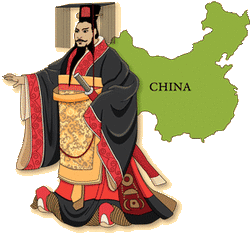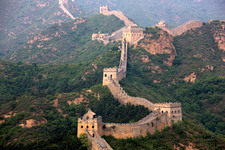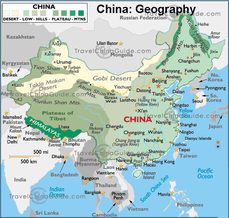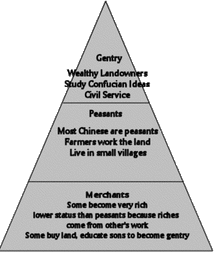03 Classical China

Classical civilizations are defined as those that had a large, enduring influence over a large number of people. The Zhou, Qin and Han Dynasties were significant as they shaped modern China. The significance of their achievements included:
- Increasing centralized the government with a growing bureaucracy to which entry to was based on merit. Peasants could join the the bureaucracy if they passed the entrance exam.
- Increasing the production of luxury goods such as silk
- Becoming the most advanced classical civilization, especially in terms of technology
- Establishing the tradition of patriarchy based on government rule and Confucian values.
- Increasing trade along the Silk Road.
- Expanding influence to include most of east and south-east Asia.
What we will study

- How the development of Classical China was influenced by its geography?
- Its social structure and political systems
- Its cultural values (art, philosophy, belief systems)
- Its impact on modern the modern world
- Roman imperialism (direct / indirect)?
- What factors (internal or external) led to the downfall of Classical China?
| Unit 4 Plan Printable Version |
The Geography of China and its Mythical Origins

The first Chinese people thousands of years ago thought they were made by a god named ‘Nuk Wa’. They believed that nobles were made from yellow clay and that commoners were made from mud. The Chinese thought that they were in the middle of the world, and so they called China The Middle Kingdom. Why?
China didn't know about many other cultures until 126 C.E. Why didn't they know about other cultures?
China had too many natural barriers around it: the South China Sea, the East China Sea, the Yellow Sea, the Gobi Desert, the Huang He River, and others. These barriers had both positive and negative impacts on China. Some positive impacts on China are that the barriers kept out invaders that were trying to get into China and take it over. Some negative impacts are the barriers kept out ideas and traditions from other countries and it kept in China’s ideas and traditions. China could not spread its’ culture throughout other places in Asia.
China didn't know about many other cultures until 126 C.E. Why didn't they know about other cultures?
China had too many natural barriers around it: the South China Sea, the East China Sea, the Yellow Sea, the Gobi Desert, the Huang He River, and others. These barriers had both positive and negative impacts on China. Some positive impacts on China are that the barriers kept out invaders that were trying to get into China and take it over. Some negative impacts are the barriers kept out ideas and traditions from other countries and it kept in China’s ideas and traditions. China could not spread its’ culture throughout other places in Asia.
Three Great Dynasties
|
Classical Chinese Dynasty
Zhou Qin Han |
Specific Characteristics
- 1029 – 258 BCE - used mandate of heaven to claim authority - worked to centralize the government - expanded territory to the south (Yangtze River Valley - rulers (emperors) referred to themselves as Sons of Heaven - standardized spoken language - 221 – 202 BCE - dynasty name gave name to country - expanded territory to the south (northern Vietnam) - construction of the Great Wall - standardized: weights, measures, money, written language - silk production encouraged and increased - construction of new roads - 200 BCE – 220 CE - bureaucracy strengthened - expanded territory south and west (central Asia, Korea, Indochina) - civil service exams based on Confucian values - trade increased (Silk Roads) - relative time of peace - patriarchy strengthened - technology: iron production, canals, irrigation systems, paper manufacture, water-power mills - social structure: elites, peasants, artisans, unskilled laborers |
Ancient Chinese Social Structure

Every society has a social structure. In ancient China people were divided into five main groups:
- The emperor was at the top. The emperor had 100% control and was wealthy from collecting taxes.
- Next there were civil servants. They worked for the emperor and could read (not everyone in China could read). They collected taxes, enforced laws, and organized building projects (like the Great Wall).
- Peasants were poor farmers and craftspeople, but were well respected and third in order because they made food and useful goods for everyone.
- Merchants were fourth and weren’t well respected because they made money by selling things other people worked hard to make.
- The ‘mean’ people who performed rough transport and other unskilled jobs and suffered the lowest status.

Ancient Chinese Families
Ancient Chinese families had three generations under one roof – grandparents, parents and children. A family’s honour was VERY important, so there were strict rules. Every family member had to respect other family members. Fathers had to work and respect every family member, especially his parents. Mothers had to do housework and care for children. They had to obey their husband and husband’s parents. The grandfather was the ‘boss’ of the house and the grandmother helped out the mother, but the mother had to obey her. Girls had to marry whomever their parents said as well as help out around the home. Children had to obey and respect their parents.
Dragon Lore
China’s first emperor, the Qin emperor, chose the dragon as his empire’s symbol. The ancient Chinese believed that dragons were in every lake, river and sea, as well as the sky and rain clouds. To the ancient Chinese dragons weren’t frightening, but wise, gentle, good and strong. An interesting idea that they thought dragons lost their toes the further they flew from China, but got them back as they flew home.
Ancestor Worship
The Chinese worshipped their ancestors since the Shang dynasty. They believed that dead family members protected them from evil and natural disasters (floods, droughts and earthquakes). They wrote questions on oracle bones. They burned a tortoise shell or ox bone until it cracked giving the answer. The ancient Chinese prepared food and drinks for them during ceremonies. There were many special pots to put food and drink in (to enjoy the afterlife).
Ancient Chinese families had three generations under one roof – grandparents, parents and children. A family’s honour was VERY important, so there were strict rules. Every family member had to respect other family members. Fathers had to work and respect every family member, especially his parents. Mothers had to do housework and care for children. They had to obey their husband and husband’s parents. The grandfather was the ‘boss’ of the house and the grandmother helped out the mother, but the mother had to obey her. Girls had to marry whomever their parents said as well as help out around the home. Children had to obey and respect their parents.
Dragon Lore
China’s first emperor, the Qin emperor, chose the dragon as his empire’s symbol. The ancient Chinese believed that dragons were in every lake, river and sea, as well as the sky and rain clouds. To the ancient Chinese dragons weren’t frightening, but wise, gentle, good and strong. An interesting idea that they thought dragons lost their toes the further they flew from China, but got them back as they flew home.
Ancestor Worship
The Chinese worshipped their ancestors since the Shang dynasty. They believed that dead family members protected them from evil and natural disasters (floods, droughts and earthquakes). They wrote questions on oracle bones. They burned a tortoise shell or ox bone until it cracked giving the answer. The ancient Chinese prepared food and drinks for them during ceremonies. There were many special pots to put food and drink in (to enjoy the afterlife).
Classroom Activities
|
|
| ||||||
Han China vs. The Roman Empire Comparative Assignment
Comparison-Contrast Essay Writing Guidance
Point by Point Method— A single characteristic of the first item is compared with a single characteristic of the second item. Then each characteristic of both items is discussed. Transitional words or phrases are extremely important in this style, so that the paper does not appear “choppy.”
Introduction—Thesis and Definitions
Section I (Political) —1(A, B)
Section II (Economic) —2(A, B)
Section III (Social) —3(A, B)
Conclusion—Connections, Inferences, Conclusions based on thesis/analysis
How to compose your paragraphs
Your paragraphs should contain an opening topic sentence, which essentially a mini-thesis statement. For example,
Han China and the Roman Empire were politically similar in that they both had strong army and were ruled by an Emperor and yet they had different structures to their governments.
You should then go on to explain in detail the similarities and differences between them and then analyze these = SAY WHY THEY WERE SIMILAR OR DIFFERENT? You should also attempt to support your writing with the opinions of other writers. For example,
‘Merchants were considered to be lower than peasants in Han China as they did not produce anything and merely made a living from the work of others. As Farah-Karls states, ‘Chinese society viewed merchants with contempt despite the vast wealth they accumulated. Confucianism taught that the pursuit of profit was unworthy of for the “superior” individual.’ (Farah-Karls pp.229) Thus Confucianism explains why merchants were held with such low regard in Han China compared to their position in Roman society.
Aim to try to include at least one quote from another author for each section you write. But remember not to use the same source again and again
Introduction—Thesis and Definitions
Section I (Political) —1(A, B)
Section II (Economic) —2(A, B)
Section III (Social) —3(A, B)
Conclusion—Connections, Inferences, Conclusions based on thesis/analysis
How to compose your paragraphs
Your paragraphs should contain an opening topic sentence, which essentially a mini-thesis statement. For example,
Han China and the Roman Empire were politically similar in that they both had strong army and were ruled by an Emperor and yet they had different structures to their governments.
You should then go on to explain in detail the similarities and differences between them and then analyze these = SAY WHY THEY WERE SIMILAR OR DIFFERENT? You should also attempt to support your writing with the opinions of other writers. For example,
‘Merchants were considered to be lower than peasants in Han China as they did not produce anything and merely made a living from the work of others. As Farah-Karls states, ‘Chinese society viewed merchants with contempt despite the vast wealth they accumulated. Confucianism taught that the pursuit of profit was unworthy of for the “superior” individual.’ (Farah-Karls pp.229) Thus Confucianism explains why merchants were held with such low regard in Han China compared to their position in Roman society.
Aim to try to include at least one quote from another author for each section you write. But remember not to use the same source again and again
